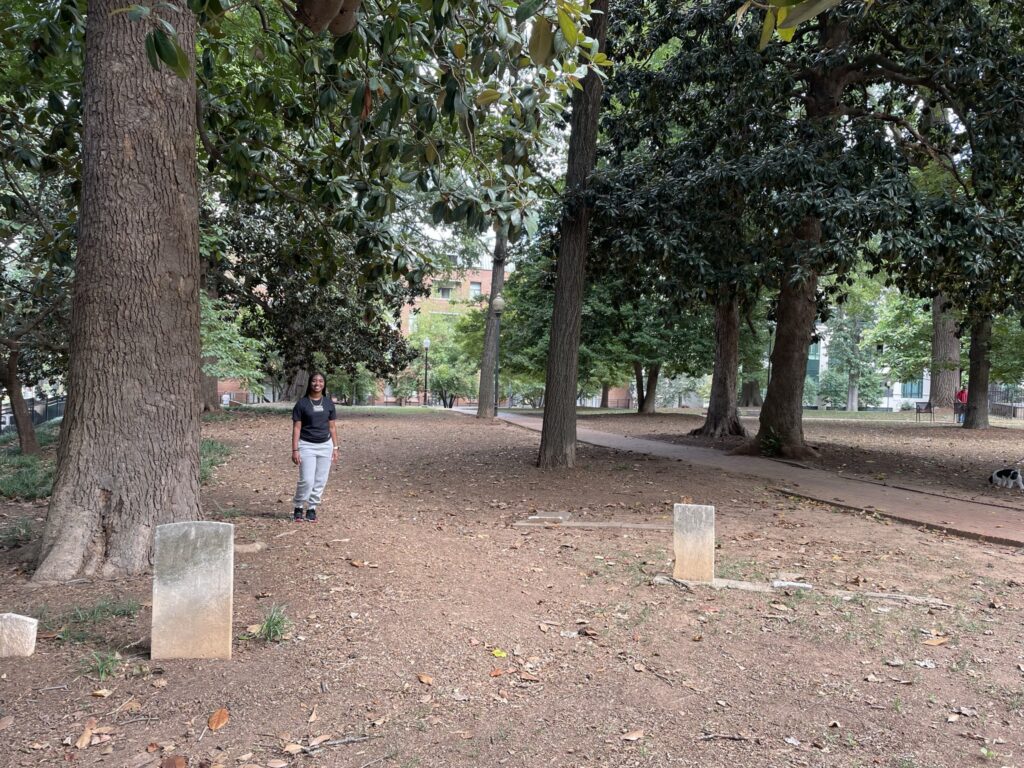
By Brenda Porter-Rockwell
What started as a Girl Scouts service award project for 18-year-old Alexia Alexander, has blossomed into a long-term partnership with two local museums.

Alexander created “Charlotte’s Lost Slavery History” digital map to earn her Girl Scout Gold Award with the local Hornets’ Nest Council. The award is similar to a Boy Scout Distinguished Eagle Scout award. A Google map and related handout highlight 18 Uptown sites organized as a walking tour, exploring areas where enslaved people once lived and worked, and even where they were sold. Find the Google map by searching keywords “Google map” and “Charlotte’s Lost Slavery History” on Google Search.

“I was determined to earn my Gold Award … because it is a special award. Only about percent of Girl Scouts earn the Gold Award, and it takes one to two years. So, it is a serious commitment,” she said.
To date, Alexander’s map has more than 7,000 hits. With support from the Charlotte Museum of History and The Harvey B. Gantt Center for African American Arts + Culture (Gantt Center), the project could reach many more.
Next year, “The museum hopes to host a guided walking tour led by a local historian who can help visitors in Uptown grapple with these stories,” said Nolan Dahm, Charlotte Museum of History, adult education specialist.
This fall, the Gantt Center will help boost the project’s reach by marketing with QR code technology. “With this code, we are now developing a rack card that will be placed in our institution and other organizations in Charlotte. The QR code and summary information will also be included on the Gantt Center rack card, which reaches thousands of visitors in the Charlotte airport, area hotels and select restaurants,” said Bonita Buford, chief operations officer for The Gantt Center.
“I just want people to know some of these facts and to put names to the unknown people who helped build Charlotte. [The map] helps people learn new things,” Alexander said.

Choosing a project idea
Getting started wasn’t easy. Having moved through the Girl Scout ranks, earning the Gold Award meant receiving the highest accolade available to Girl Scout Seniors and Ambassadors. The project tasked her with finding and researching an important community issue that would make lasting change. In addition, Alexander had to write a proposal, gather experts on the topic and develop an adult support team, all while maintaining top grades in high school.
An animal science major at North Carolina State University in Raleigh, Alexander naturally first turned to a local shelter, which needed their entryway painted and their building pressure washed. Unfortunately, that wasn’t a big enough community impact. Next, she considered the Civil Rights Movement or Charlotte’s Second Ward High School, but their histories had been covered.
“When my mother saw that I was stalling in filling out the paperwork she sat me down and asked what would excite me. The thing I had been most excited about recently was learning about Black history in a class I took at Myers Park High School in my junior year. I just didn’t know how to use that in a project,” Alexander recalled.
Her mother, Bernice Clark, was her biggest fan, followed by support from some of her Girl Scout troop leaders who guided her through library research and edited her project details.
“I wanted to do something that wasn’t so well known. I was especially interested in Black people in Charlotte before the Civil War. My father’s family can be traced to the 1840s in Charlotte and I am almost certain they were enslaved. That was a starting point for me wanting to find out what their lives were like,” she said.
For experts on local African American history, she turned to Nolan Dahm, Adult Education Specialist at the Charlotte Museum of History.
“We were happy to help connect her with experts in the field who directed her to some great archives and historic resources around the city,” explained Dahm.
The Gantt Center was also happy to help since it is the first stop on the map.
“We were excited and proud to connect with Alexia on such a rich, historical initiative which would educate so many people in our community — many who are unaware of the history of slavery in our own backyard,” said Buford.
Living history
Among the many facts Alexander learned while researching the project were stories of enslaved people sold at the old Charlotte courthouse at the intersection of Trade and Tryon Streets.
“The building is gone, but the location is only a block off the intersection of Trade and Tryon streets. I have been to Charleston, South Carolina. I knew there was a slave market there, but it had never really hit me that such a thing happened right here in my hometown. Seeing a picture of the building where it happened was sad,” said Alexander.

Another fact that stuck with her: gold mines running beneath the streets of Charlotte.
“Hundreds of enslaved people worked in those mines. I wonder what it was like for them every day to go down into a dark and dangerous situation and not even get to keep the gold they were mining?” she said.
Alexander added, “Black people helped build and maintain the railroad, too. So, I began to see that a lot of the things that kept the city running and that helped build Charlotte was the work that enslaved people did.”
She also can’t forget the stories of local runaway slaves.
“I think it was a hard choice to run away because there wasn’t really anywhere to go that was safe,” Alexander said. “Their dream, I think, was to make it to the North, but that is a long way from Charlotte. The fact that so many people ran away shows how desperate they were.”

